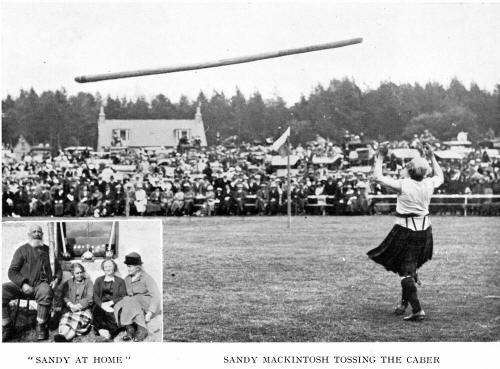|

"To thee, lov'd Dee, thy
gladsome plains
Where late wi' careless thought I ranged,
Tho' press'd wi' care and sunk in woe,
To thee I bring a heart unchanged.
I love thee, Dee, thy banks
and braes,
Tho' there remembrance wake the tear;
For there he roved that brake my heart,
Yet to that heart still fondly dear."
IT was a perfect autumn day
when I left the comfortable hostelry of the Invercauld Arms at Crathie,
sometimes known as the Inver Inn, and walked along the main road eastwards
till I found the rough but picturesque path to the abode of this
celebrated athlete. The columns of the press and his portrait have made
his fame and features familiar to admirers of muscular super-excellence
all over the world, and I felt myself specially favoured to come, all
unworthy, into the presence of this noted giant. My first impression was
that of astonishment at the size of his legs. Not being a man of indoor
games, I do not know what size the legs of a billiard table should be, but
if I were ever the possessor of a Burroughes and Watts that broke down and
needed support during repair, I would confidently invite Sandy to place
his huge knees under one end, and firmly believe he would support it
single-handed, or double-kneed, so to speak.
Born on September 28th, he
is a bachelor in his seventy-seventh year, and formerly lived at Lawsie,
opposite to Balmoral, 1,600 feet above sea-level, and has followed the
plough for over fifty years. His cheerful house, called Rhynebaich
(sounding like Ronnybake to my ears), contains the trophies he has won, of
which an illustration appears opposite page 187.
An old Volunteer, he won
the Queen's Cup in 1874. He won first prize for ploughing at the Crathie
Agricultural Club and has seven medals in all, in addition to countless
other things. The first won was in 1863 at Glengairn, when he put the 16
lb. stone 40 feet 4 inches.
2nd, 1873. 1st for same, 22
lb. 32 feet ii inches at the Ballater Highland Games.
3rd, 1877. 1st, Ploughing at Crathie.
4th, 1879. 1st, ditto.
5th, 1896. Rifle Volunteer Shooting.
6th, 1923. A medal presented by W. Robb, jeweller to the King, for having
competed fifty years at Braemar.
7th. The ordinary Long Service Volunteer Medal.
When he was seventy-one he
took second prize for tossing the caber, but has not competed since 1923.
His height is 6 feet 1 inch; weight, 16 stone; calf, 181 inches; chest, 45
inches. A caber weighs roughly 2½ cwt.
When he was forty-six years
of age he could lift three weights of 56 lb. each off the floor with his
teeth, viz., 12 stone. Some feat !
Sandy relates the following
true anecdotes :-
His Royal Highness the
Prince of Wales was asked at one gathering if he would like to see the
mighty athletes from Deeside.
"Dee-cidedly !" His Royal
Righness is reported to have replied; a spontaneous instance of Royal
facetiousness.
Fifty years ago the Prince
was out shooting in the Balmoral district. As it was a wet day, and
"Sandy" was out, he turned to Colonel Baring, who was close to him, and
said: "Give your mackintosh to Mackintosh. He is a Mackintosh." Colonel
Baring said he wished he had a hundred thousand more men like him, then
Great Britain need fear no foe. In matters musical, Sandy excels in
singing the song called "Fireman Smith."
When the gathering was at
Mar Castle one year, Sandy remembers Prince Leopold's tutor being a
competitor in a hurdle race, who on this occasion dived into a pool in the
Dee during the race, and thus got on faster than the rest of the runners,
who waded over in their kilts. He won the first prize of £5, but returned
it to the Society. The late W. McCombie-Smith, the well-known athlete and
author of "Athletes and Athletic Sports of Scotland," once said that if
Sandy had only trained and practised, he would certainly have beaten the
famous Donald Dinnie himself, of whom I give a lengthy notice, commencing
on page 173. A more genial man one rarely meets.
It was also my privilege to
meet Sandy's brother Charles in his delightful garden at Ellangowan,
Braemar. Although busily engaged in trimming a wonderful hedge of sweet
peas, he was full of courtesy and information. Not only was he the Royal
standardbearer at the games for many years, but he is also president of
the Royal Horticultural Society of Braemar. He does not approve of the
fell racing at all, and believes His Majesty the King is not fond of the
wrestling, or it would appear sooner on the programme than it does. He
recollects the time when photographs were first taken before 1874, because
they all had to stand perfectly still for several seconds, the
instantaneous process of modern days not having been invented.
A portrait of Mr. Charles
Mackintosh appears opposite page -8. As regards the shoulder-belt, which
was a prize in 1824 presented by William Farquharson, I was glad to learn
from the treasurer, Mr. John Ewan of Hillside Cottage, behind the
Episcopal Church near the Invercauld Arms Hotel at Braemar, that it was a
sort of masonic sash, apparently now in the possession of the relatives of
Angus
McIntosh of Glendussie. It
was made of Stuart tartan, and had on it in gold lettering "Wrights'
Society." He also kindly informed meat our pleasant interview that the
snuff-box, for tossing the caber in 1859, won by G. Hutchinson at Balmoral,
is now with Mrs. Hutchinson at Cliff House, near the Fife Arms Hotel.
"O vous qui buvez, à tasse
pleine,
A cette heureuse fontaine,
Ou on ne voit, stir le rivage,
Que quelques vilains troupeaux,
Suivis de nymphes de village,
Qui les escortent sans sabots...." |

